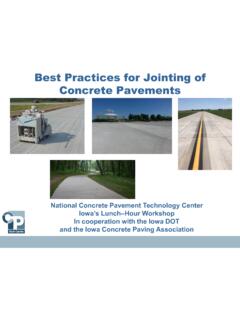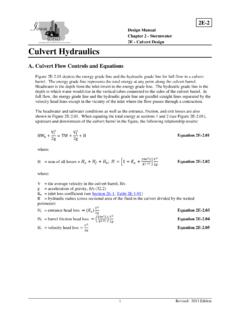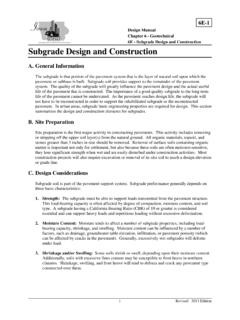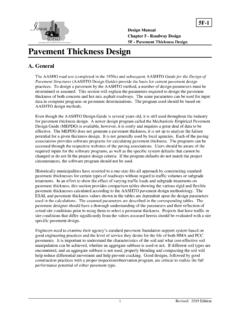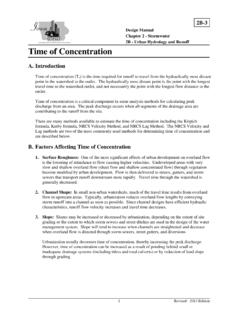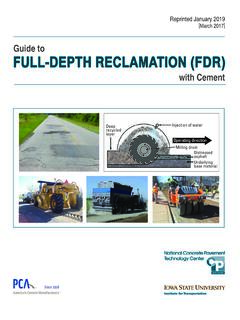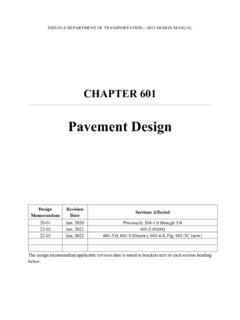Transcription of Soil Cement Stabilization - Institute for Transportation
1 SOIL Cement STABILIZATIONBETTER CONCRETE CONFERENCEFALL 2018 TYPES OF SCS Cement Modified Soils (CMS) Cement Stabilized Subgrades (CSS) Cement Treated Base (CTB) full depth reclamation (FDR) Updated Guide to Cement Modified Soil ~ PCA Publication 2008 Cement Modified Soil (CMS): A mixture of pulverized in-situ soil, water and small proportion of Portland Cement resulting in an unbound or slightly bound material, similar to a soil, but with improved engineering properties. Cement Stabilized Soil (CSS): An engineered mixture of pulverized in-situ soil, water and moderate proportion of Portland Cement , resulting in a semi bound to bound material, with engineering properties similar to an granular material.
2 Will still provide improved soil shear and compressive strength. DEFINITION Cement Treated Base (CTB): Fully bound engineered mixture of soil/aggregate, water and sufficient Portland Cement to meet the project specified minimum durability and strength requirements. CTB can be mixed-in -place using on-site soils or mixed in a central plant using selected aggregate. Usually FAA projects Typical 7-day unconfined compressive strengths range from 300 800 psi. DEFINITION full depth reclamation (FDR): F u l l- depth reclamation (FDR) rebuilds worn out pavements by recycling the existing roadway in-situ.
3 The old pavement section and base materials are pulverized, mixed with Cement and water, and compacted to produce a strong, durable base for a new pavement surface. ~PCADIFFERENCES IN SCS Cement Modified Soils (CMS) Intended to improve / modify subgrade Uses low dosages of Cement Cement Stabilized Subgrades (CSS) Intended to improve / modify subgrade Uses higher dosages of Cement Cement Treated Base (CTB) Intended to create a structural base Uses higher dosages of Cement Typically used for FAA Projects full depth reclamation (FDR) Intended to create a structural base Used widely to address existing pavement complete structural failures Uses higher dosages of cementVirgin SoilCMS / CSSCTBDIFFERENCES IN SCS TREATMENTS Cement Modified Soils (CMS) Typical Dosage 3 5 % Cement Stabilized Subgrades (CSS) Typical Dosage Greater than 5 % Cement Treated Base (CTB) Typical Dosage Varies based on project requirements / design PCA recommends 3 10% full depth reclamation (FDR) Typical Dosage 3-10% (could be up to 15%)IS SCS FOR MY PROJECT?
4 What type of pavement support are you trying to achieve? What type of problematic soils are you trying to overcome? Wet, expansive, low strength, etc. How are the soils behaving on your project? Will they allow for the desired outcome? Are they hindering construction progress? What if I m in the construction phase and the soils deteriorate on the project? At this point in the process, you should call a geotechnicalengineer WHICH SCS IS RIGHT FOR MY PROJECT? SCS will improve soil subgrade properties Strength Chemical composition (expansive soils) Freeze/thaw durability Shrink/swell characteristics Drying of soils Use the above list to determine which SCS process you SCS IS RIGHT FOR MY PROJECT?
5 SCS TypeDefinitionCement %ApplicationCMSSoil , Water, Cement3% - 5%Soft subgradesCSSE ngineered Soil , Water, Cement ,Unbound>5%Soft subgrades or subgrade requiring increase in strengthCTBE ngineered Soil , Water, Cement , Bound3% - 10%to achieve projectspecified strength requirementsFDRE ngineered Soil , Water, Cement , full Pavement Reconstruction5% - 8%Improve bituminous surfaced roadwaySTEPS FOR USING SCS Identify the need for improving soil conditions Identify the types of soils present Implement the mix design process Apply to construction methodsDECISION TREEIDENTIFY THE IN-SITU SOIL CONDITIONS Wet, expansive, unstable?
6 Obtain soil samples and classify them to understand where the problems are. Every soil is unique! At this point in the process, you should call a geotechnicalengineer IMPLEMENT A DESIGN PROCESS Soil samples should be tested to determine virgin soil properties. Design SCS depending on desired outcome and virgin soil properties. Which SCS does your project need? Select a range of Cement dosages to verify. At this point in the process, you should have called a geotechnicalengineer WITH A GEOTECHNICAL ENGINEER IS IMPERATIVE THROUGHOUT THIS SAMPLING FOR MIX DESIGN Sample Frequency Common to obtain every 400 ft.
7 Usually to a depth of 10 ft below grade. Obtain soil samples and run laboratory testing General soil classification tests Proctors Atterbergs ( Liquid Limit, Plastic Limit, Plastic Index) Grain Size Analysis (Hydrometers) AASHTO classifications Most Iowa soils are A4, A6 or A7 (Silty or Clayey Soils) classificationMIX DESIGN PROCESS The amount of Cement the soil will need is dependent on Grain size / particle distribution Desired support from subbase Type of SCS selected Determine which Cement type to use. Soil sulfate content will dictate. Should test 3 to 4 dosage points to determine optimum DESIGN PROCESSD etermine Soil ConditionDetermine Cement Type and Dosage RatesDetermine Chemical Compatability (If Necessary)Prepare Samples With 3 Different Cement Contents ( 2%, 4%, 6%)Determine SL, PL, LL, of Sample (Atterberg Limits) of the 3 Samples 1 Hour After MixingDetermine Optimum Moisture Content and Maximum Dry Density of the 3 SamplesDetermine the Unconfined Compressive Strength of the 3 SamplesDetermine the Freeze-Thaw Durability of the 3 Samples (If Cold Weather State)
8 Plot Unconfined Compressive Strength and Freeze/Thaw Durability on a Graph to Verify Cement ContentCreate Mix Design ReportAPPLY TO CONSTRUCTION METHODS Communicate the intended outcome and design with earthwork contractor. Cement should be incorporated using appropriate equipment. Reclaimer/Mixer Grader Cement Spreader Water Truck Tamping/Sheepsfoot/Pad Foot Roller (Clayey and Silty Material) Smooth Drum Roller (Granular Soils) / Pneumatic Tire Roller (Optional)APPLY TO CONSTRUCTION METHODS APPLY TO CONSTRUCTION METHODS SCS should be compacted in place, prior to Cement hydrating.
9 Sometimes you might have to add water! Have your geotechnical engineer / representative assist with incorporation. Monitoring dosage applications. Monitoring compaction TO CONSTRUCTION METHODS QC/QC during incorporation should included at a minimum Proof roll the virgin subgrade first Need to stabilize deeper? Contractor should verify equipment in good working order Water hose not clogged Teeth on reclaimer not missing Confirm application rate Conduct a test strip Identify if lab scenario can be applied to field Verify Stabilization efforts with moisture/density testing Frequency of every 5,000 sq.
10 Ft. Curing time (?)PCA PhotoAPPLICATION TECHNIQUES APPLICATION TECHNIQUES TYPICAL APPLICATION RATESP ercent Cement By WeightPercent Cement B y Vo l u m e% Cement Spread Requirements in Pounds Per Square Yard (kg/m3) for Compacted Thicknesses100 pcf (1602 kg/m3)110 pcf (1762 kg/m3)5 inches (125 mm)6 inches (150 mm)7 inches (175 mm)8 inches (200 mm)9 inches (225 mm) ( ) ( ) ( ) ( ) ( ) ( ) ( ) ( ) ( ) ( ) ( ) ( ) ( ) ( ) ( ) ( ) ( ) ( ) ( ) ( ) ( ) ( ) ( ) ( ) ( ) ( ) ( ) ( ) ( ) ( ) ( ) ( ) ( ) ( ) ( ) ( ) ( ) ( ) ( ) ( ) ( ) ( ) ( ) ( )
